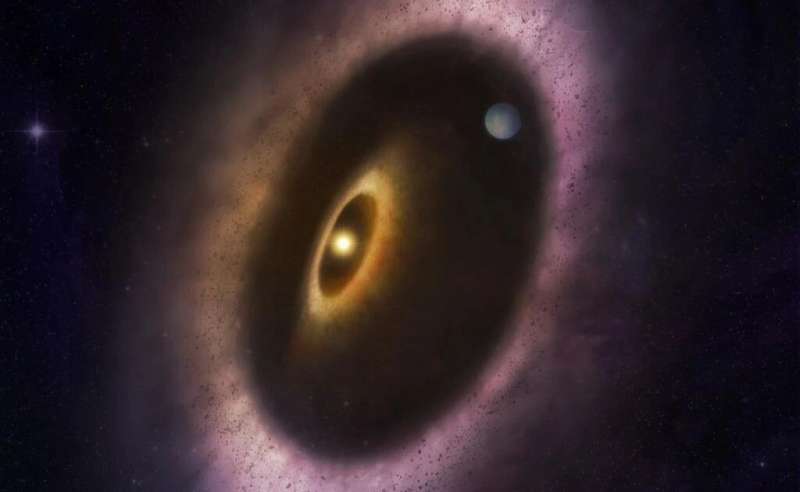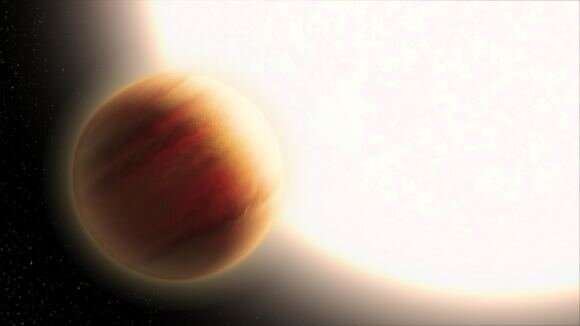Astronomers directly image a Jupiter-sized planet orbiting a sunlike star

According to the most widely-accepted theory, planetary systems form from large clouds of dust and gas that form disks around young stars. Over time, these disks accrete to create planets of varying size, composition, and distance from their parent star. In the past few decades, observations in the mid- and far-infrared wavelengths have led to the discovery of debris disks around young stars (less than 100 million years old). This has allowed astronomers to study planetary systems in their early history, providing new insight into how systems form and evolve.
This includes the SpHere INfrared survey for Exoplanets (SHINE) consortium, an international team of astronomers dedicated to studying star systems in formation. Using the ESO’s Very Large Telescope (VLT), the SHINE collaboration recently observed and characterized the debris disk of a nearby star (HD 114082) in visible and infrared wavelengths. Combined with data from NASA’s Transiting Exoplanet Space Satellite (TESS), they were able to directly image a gas giant many times the size of Jupiter (a “super-Jupiter”) embedded within the disk.
The SHINE team was led by Dr. Natalia Engler of the Institute for Particle Physics and Astrophysics (IPA) at ETH Zurich. She was joined by astronomers from the European Southern Observatory (ESO), the Space Telescope Science Institute (STScI), the Max-Planck-Institute for Astronomy, the Academia Sinica Institute of Astronomy and Astrophysics, and multiple observatories and universities. The paper that describes their findings is scheduled to appear in the journal Astronomy & Astrophysics and currently available on the arXiv preprint server.
As they state in their paper, the team relied on the Spectro-Polarimetric High-contrast Exoplanet REsearch (SPHERE) instrument on the VLT to take optical and near-IR images of HD 114082, an F-type star (a yellow-white dwarf) located in the Scorpius–Centaurus association—a stellar cluster located about 310 light-years from Earth. Like the 500 stars surveyed by the SHINE team, HD 114082 is a young star surrounded by a protoplanetary debris disk (from which planets form). Observations of these disks in recent decades have shown that they are an integral part of planetary systems:
As Dr. Engler told Universe Today via email, these surveys date back to 1983 and the discovery of the first disk around Vega. Since then, dozens of surveys have been performed in infrared wavelengths and scattered light using space-based telescopes like the Herschel Space Observatory and the venerable Hubble and ground-based telescopes like the Atacama Large Millimeter-submillimeter Array (ALMA), the Gemini Planet Imager (GMI), and SPHERE/VLT. As she explained:
“These studies provided valuable information about the formation and evolution of planetary systems since planets are formed from, reside in, and interact with the dust material. Young debris disks (in the first hundred million years) trace the processes of terrestrial planet formation, and thus studying them helps us to understand the dynamical interaction and evolution of terrestrial planets, in particular the Earth, in the young solar system.”

Using Sphere, Engler and her team observed HD 114082 in the optical and near-infrared using the angular differential imaging (ADI) and polarimetric differential imaging (PDI) techniques. The former consists of acquiring high-contrast images from an altitude-azimuth telescope while the instrument rotator is off, allowing the instrument and telescope optics to remain aligned and the field of view to rotate relative to the instrument. The latter involves combining different incident polarizations of light and measuring the specific polarization components transmitted or scattered by the object.
Both techniques have been used extensively in the study of circumstellar debris disks and (according to Engler) revealed some interesting things about HD 114082:
“Our images revealed a bright planetesimal belt at a distance of 35 AU from the host star, very similar to the Kuiper belt in the solar system. The debris belt is inclined at 83° and has a wide inner cavity. The dust particles, which we trace in this observation, have sizes around 5 microns and a relatively high scattering albedo of 0.65; this means they scatter nearly two-thirds of incoming stellar radiation and absorb only one third of it. The scattered light has a relatively low degree of linear polarization with a maximum of 17% which, however, is comparable with the polarization values for cometary dust in the solar system.”
The team also consulted data from TESS to confirm the presence of a super-Jupiter companion, which was first detected by the observatory in 2021 using transit photometry (aka. the Transit Method). Consistent with this data, Engler and her colleagues confirmed that the planet orbits its parent star at approximately 0.7 AU—about the same distance between Venus and the sun. Recent observations based on radial velocity measurements confirmed this planet and produced mass estimates about eight times that of Jupiter.
“HD 114082 provides an example for young planetary systems, where the presence of planetary companions to the host star has been inferred from the discovery of a debris disk,” Engler added. “This confirms the theoretical considerations of debris systems as signposts for young planets. Studying this and other similar planetary systems will allow [astronomers] to establish a link between the properties of extrasolar Kuiper belts and planets residing within them.”
The implications of this study go beyond the study of young stars and planetary systems that are still in formation. They are also significant for studying our solar system, which has some interesting parallels to these protoplanetary environments.
Said Engler, “The direct imaging studies of the last decade show that the circumstellar material in many debris disks is confined to ring-like structures, similar to two debris belts in the solar system: the Edgeworth-Kuiper belt and the main asteroid belt. The cavities inside the extrasolar Kuiper belts are curved by unseen planets, which leave their imprints in the debris dust distribution, such as warps, clumps and belt eccentricities.”
Lastly, this study demonstrates the growing use and effectiveness of direct imaging studies, which are possible thanks to improved instruments, imaging capability, and data-sharing methods. In the near future, next-generation instruments will allow for even more accurate and detailed direct imagining studies. These include space-based observatories like the JWST and the Nancy Grace Roman Space Telescope and ground-based telescopes like the Extremely Large Telescope (ELT), the Giant Magellan Telescope, and the Thirty Meter Telescope (TMT).
By studying the geometry and asymmetric features in debris disks, astronomers can predict the location and masses of planets that are not yet detectable with current instruments. “Direct imaging makes it possible to study the scattering properties of dust particles around distant stars,” Engler added. “These properties contain information about particle composition, shape, and size, and thus we can gain insights into the composition of the building blocks of exoplanets.”
More information:
N. Engler et al, The high-albedo, low polarization disk around HD 114082 harbouring a Jupiter-sized transiting planet, arXiv (2022). DOI: 10.48550/arxiv.2211.11767
Citation:
Astronomers directly image a Jupiter-sized planet orbiting a sunlike star (2022, November 30)
retrieved 30 November 2022
from https://phys.org/news/2022-11-astronomers-image-jupiter-sized-planet-orbiting.html
This document is subject to copyright. Apart from any fair dealing for the purpose of private study or research, no
part may be reproduced without the written permission. The content is provided for information purposes only.
For all the latest Science News Click Here
For the latest news and updates, follow us on Google News.

